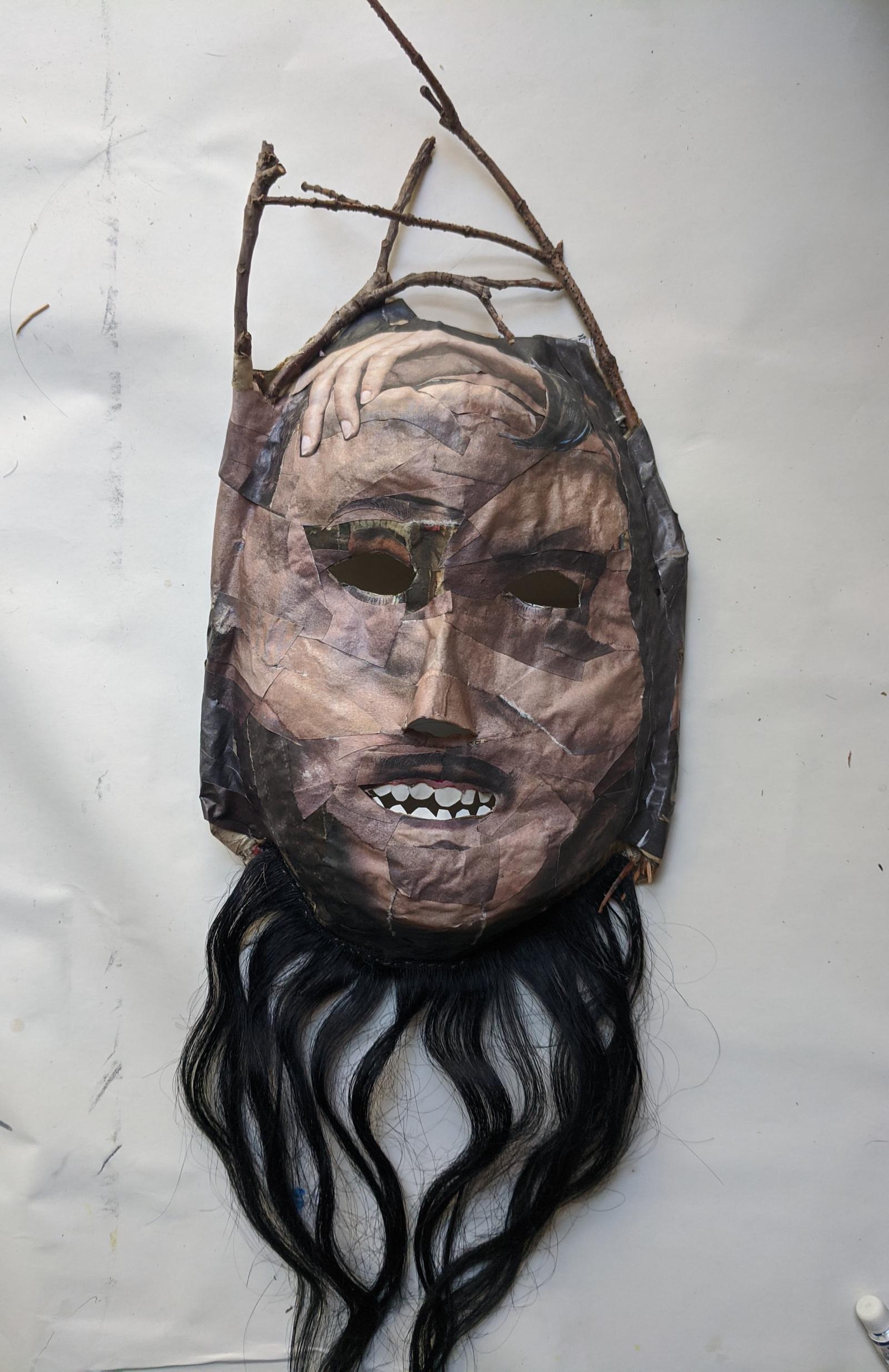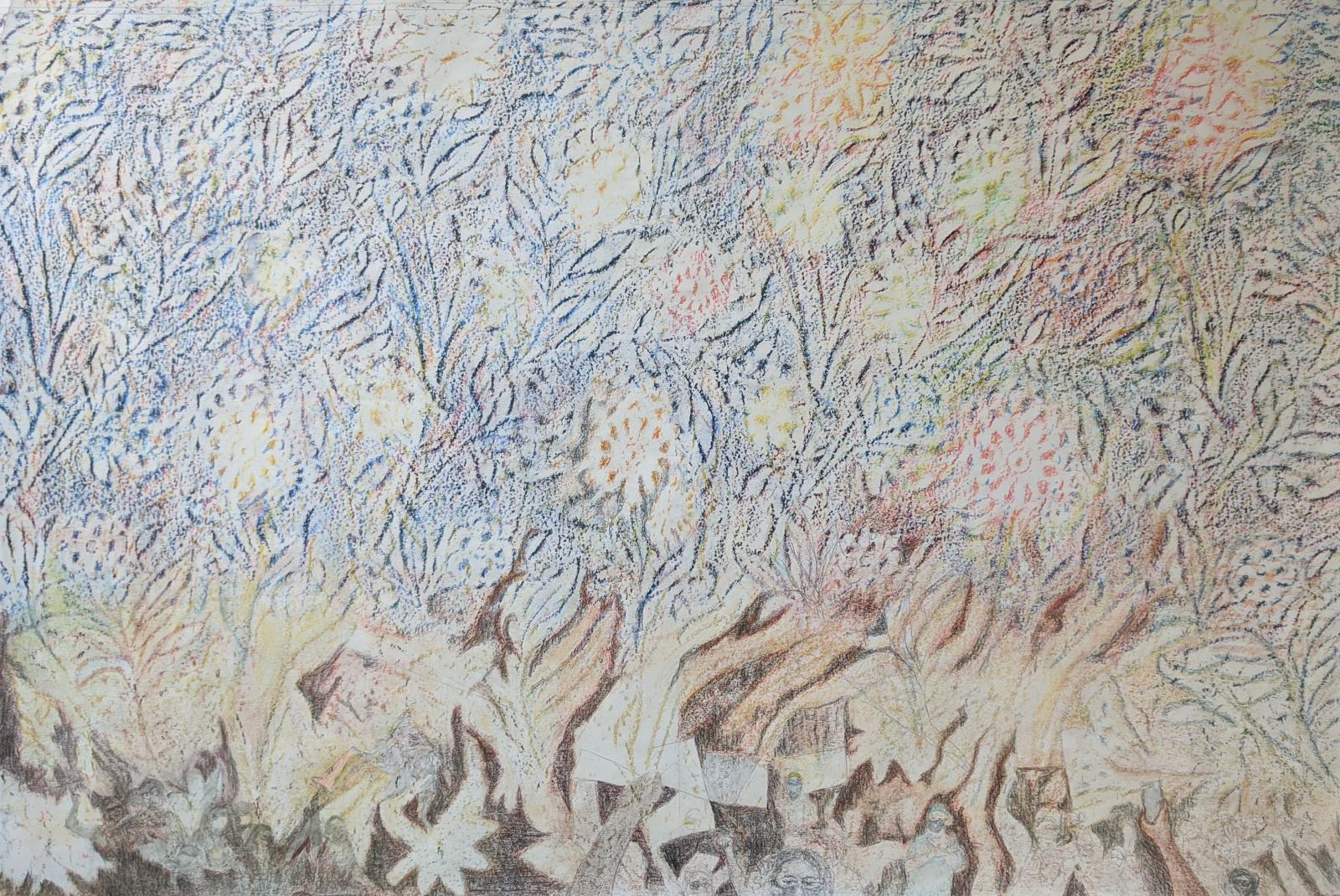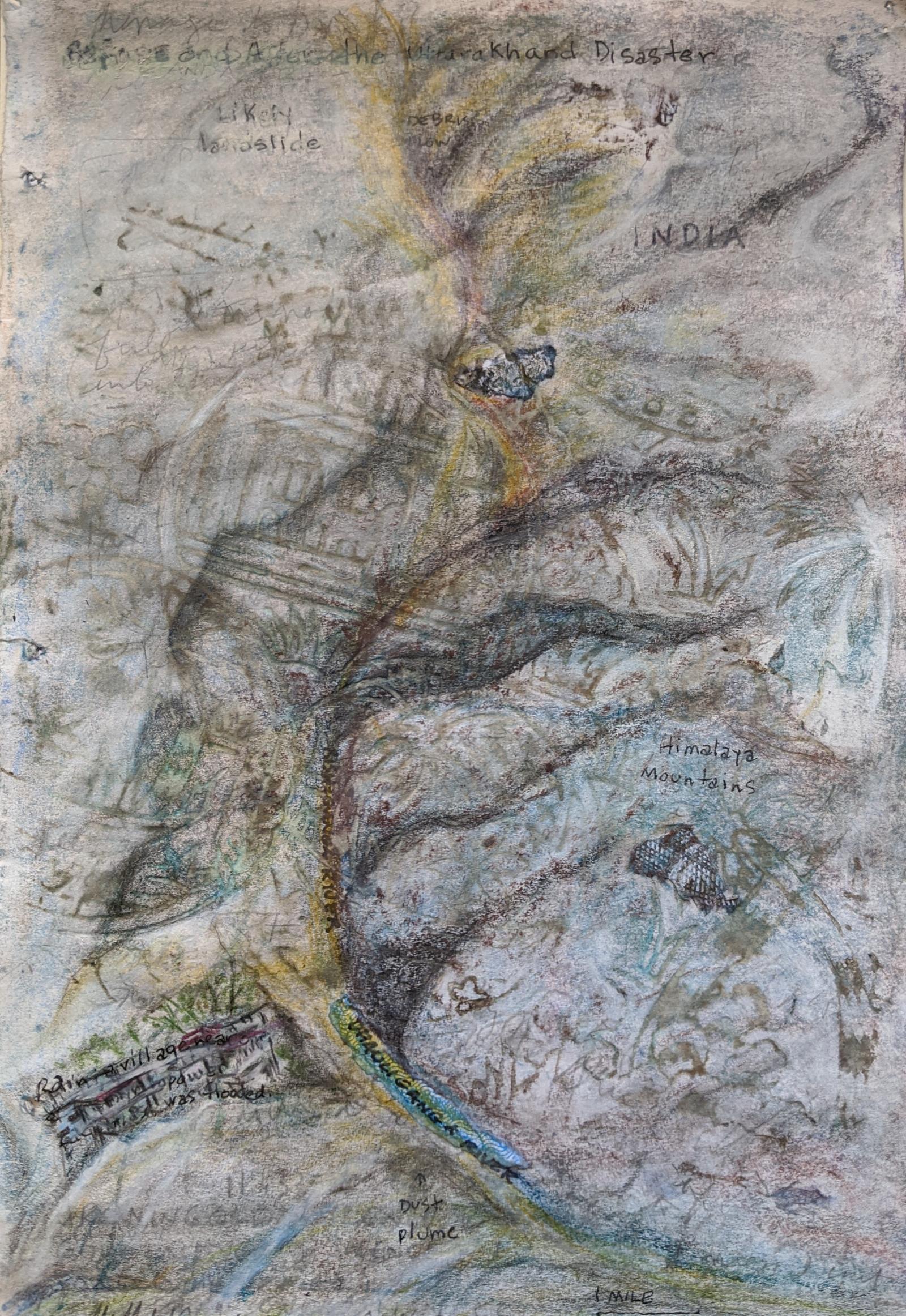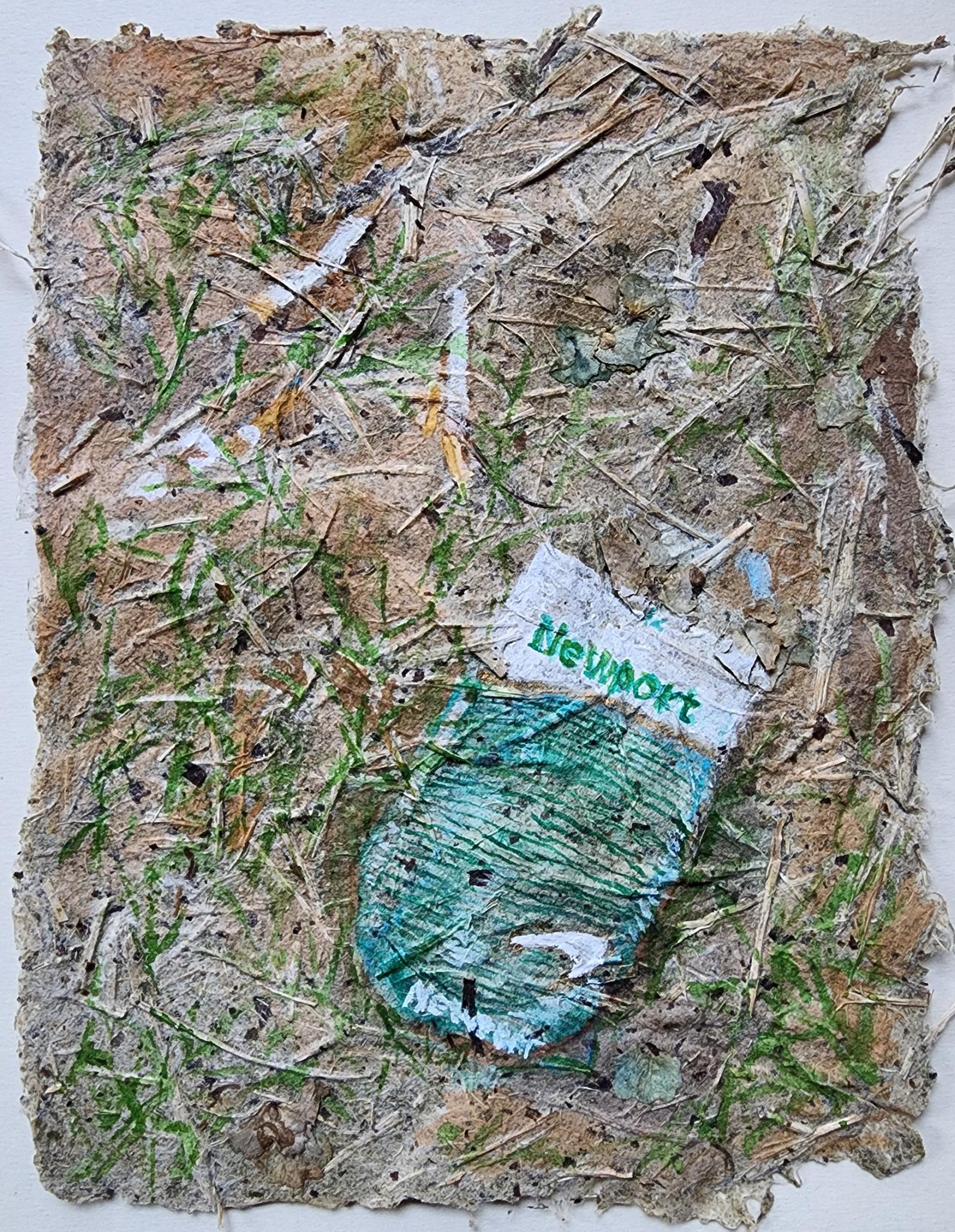As a visual artist, I am very interested in palimpsests, the layering of text and images over other, older texts and images. As an artist with a life-long hearing impairment, I am very interested in the way that palimpsests are a visual representation of hearing loss; text is hidden within the drawing, appearing and disappearing under various conditions. Masks were created by layering, as paper mâché, newspapers over aluminum carry-out containers and animal skulls, afterwards removing the base. Drawings and paintings were created by layering text and images over rubbings of tree trunks, historic wall coverings, architectural structures and hand-made paper from weeds found in vacant lots in Baltimore City.
About the Artist
Annette Wilson Jones received her BFA from MICA in 1978 and, in 1980, she was hired by Beautiful Walls for Baltimore as a full-time muralist. In 1986, her work was chosen by New Museum Curator Brian Wallis for a five-person show, Sweet Land of Liberty, at School 33 Arts Center; was featured and awarded an honorarium by Baltimore City Paper for her drawing, Self-portrait as St. Sebastian, Tattooed on My Husband’s Back; and she had her first child/ spiritual guide. Throughout the past forty years, her work has been included in visual arts exhibitions throughout Maryland and in shows that traveled to: DC, PA, NM, NY, NC, VA and Lund, Sweden. In 2019, her work was selected for the Second Tri-Annual Maryland State Artist Registry Juried Exhibition and for the 31st National Drawing & Print Exhibition for which Juror Doreen Bolger awarded a Purchase Prize for the permanent collection of the Gormely Gallery at Notre Dame of Maryland University.Artist's Statement
Born in interesting times (as promised in the curse), raised up through the bombings and assassinations and wars and riots and hijackings — no news seemed to be good news but I tried to keep up. Then came demonstrations and freedom marches and community organizing and hope for the future, so I left my nuclear home for Baltimore to go to art school. Assured that equality was ascendant, the population bomb would not ignite, women’s bodies were their own, and waste would be curbed for all time the news fell further into background chatter. It appears that I must have misinterpreted what I heard. Lectures, shared confidences, noises on the street, ringing in my ears- all added to the chatter and fought for attention. At the age of 26, I was diagnosed with a “significant” hearing loss — but only provided with one hearing aid. At the age of 55, I finally got two, matched, digital hearing aids. For the past two decades, or so, my work has been an exploration of how to create visual analogies of hearing impairment. I found that there were audiology research papers on “analogies of hearing impairment” with titles like “Perceptual Interference in Everyday Settings” and “Degraded Grouping” — yes, exactly! My most recent work uses text from books, news articles, my (probably impaired) transcriptions of radio news shows, combined with rubbings of objects that I find, various printing methods and drawings from news photographs and observational drawings. I have begun to experiment with making paper and ink from weeds, plants, berries, and metals found in vacant lots around Baltimore City. The subject matter of these works most often addresses issues such as: climate change and other concerns for our planet; violence and inequity in our communities; healing and positive change that must take place and, recently, the history of nuclear testing in the Marshall Islands — the latter of which encompasses the previous issues. Those subjects are "heavy" but I try not to be heavy-handed or focus too heavily on what has happened in the past, instead focusing on what we can do to work together now and in the future. I often use humor in my work to make my point; with no intention of "making light" of any specific issue but in order to bring light to the subject matter, illuminating what might be difficult to see, allowing time for the eyes to adjust.Featured Work
Photos




Featured Work: Photos
Calling a Golem, made from earth, to save this Earth and all living beings
Paper mâché with sticks and found hair extensions.
2023
This is a mask of a golem. According to Jewish folklore, a golem is made from clay/mud/earth (as was Adam in the Book of Genesis) and can be called into being, to save or destroy.
In this piece, I imagine a golem that can be called into being, from the earth, to save the Earth and all living beings. The mask is paper mache, made from newspapers, layered over an aluminum foil, carryout food container. I made the teeth from a paper plate. The sides of the wet paper mâché were rolled over sticks to branch out of the top of the head; hair extensions were washed, conditioned and combed out to create the beard.
The photograph is of the front of the piece, the reverse is also finished with paper mâché and includes quotes from Genesis. My next door neighbor was a pastor in a local church and left a Bible outside, in her window, when she had to move. Her intention may have been to put a blessing on the house, or to ward off bad spirits, or for it to dissolve on exposure to the elements and return to the earth.
For Sale
$200.00
Contact the artist to purchase this piece
There were fireworks every night and the sparks fell to the earth like flowers — Freddie Gray, George Floyd, Breonna Taylor....
Graphite over colored pencil on paper
2021-2023
Rubbings of pressed tin wall covering were made with woodless colored pencils. The rubbings suggest both flowers and fireworks. Over the bottom third of the piece, drawn images of protesters, taken from a variety of photographs following the deaths of Freddy Gray, George Floyd, and Breonna Taylor were layered over faint rubbings of the same pressed tin wall covering. Text was added to the flowers/fireworks that list the names of all of the Valedictorians and Salutatorians that graduated from Baltimore City high schools in 2021.
For Sale
$1,000.00
Contact the artist to purchase this piece
Uttarakhand Disaster 6/16/13
Graphite, colored pencil, pastel, ink and collage on paper
2021-2023
Drawing based on images of the "Uttarakhand Disaster", a disastrous flood resulting in landslides in the North Indian state of Uttarakhand on June 16, 2013. Over 5,700 people were reported killed; the number was later updated to 6,054 — that number could still be an undercount. At that time, it was considered to be the worst natural disaster in. India since the 2004 tsunami. There are many layers to this drawing: it began as notes from telephone messages received in an office, using government-issued pencils with old erasers; over those smeared and, perhaps, misheard messages parts of office envelopes that had patterns to obscure the contents of the envelope; over that, a drawing of lightning which was later erased; then, the drawing of the Uttarakhand Disaster, based on contemporary news reports with text describing the disaster and, finally, a rubbing of an antique wooden block, from India, that was used to print textiles.
For Sale
$200.00
Contact the artist to purchase this piece
Pack of Newports # 3
watercolor and gouache on hand-made paper
2024
A painting of a pack of Newports with three cigarettes. This is one of a series of paintings of a pack of Newports and three "loosies"— though these were likely dropped and were not for sale. Empty packs of Newports can be found all over downtown Baltimore and have almost become an icon of Baltimore. In this painting, I allowed the texture of the paper to come through strongly, making the pack of cigarettes and the loosies to almost disappear into the surface.
For Sale
$200.00
Contact the artist to purchase this piece
Vacant lots are full of stories, a sad pack of Newports and three loosies
watercolor and gouache on hand-made paper
2023
Watercolor and gouache on paper made from a "weed" tree, an invasive species of mulberry. I chose to keep much of the texture and color of the bark and leaves that were used in the paper making process. The items depicted in this painting were photographed in the so-called vacant lot behind my house. The sight of a pack of Newports, a brand of cigarettes that is ubiquitous in Baltimore, and three previously whole cigarettes lying in the mud and weeds spoke to me of someone's small tragedy, a small loss but I'm sure one that was grieved.
For Sale
$200.00
Contact the artist to purchase this piece
A lot of moments, a lot of stories
watercolor and gouache on hand-made paper
2024
This small watercolor and gouache painting was made on paper made from a "weed" tree that was growing in a vacant lot near my house. In preparation for a paper making class at Pyramid Art Center; I cut a branch that was growing over and onto a car that was parked on the street nearby.
The images are of items that were found in another so-called vacant lot behind my house in Baltimore City. The lot is actually full of a lot of stories — those of the people who lived and loved and worked and played in the houses that used to fill that lot.
The items were not all there at the same time but were in the same approximate space over time; I did not dig into layers of soil, so they were not in the exact same space at the exact same time, but were all found over a period of time, in that lot, gathered and brought into my studio. I also took photographs of the objects and the soil, rocks and weeds that now fill the lot to help recreate the way that objects forced themselves to the surface after rains washed away the top layers.
For Sale
$200.00
Contact the artist to purchase this piece

